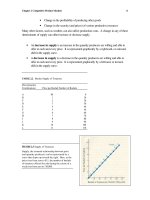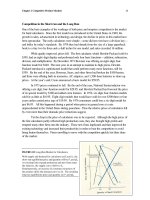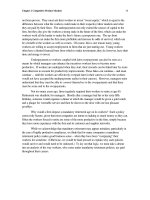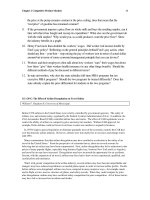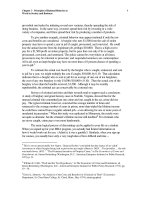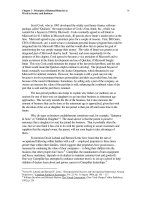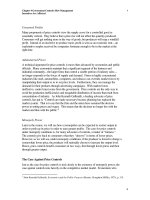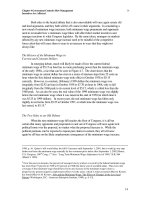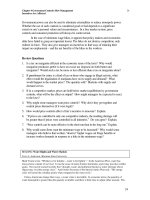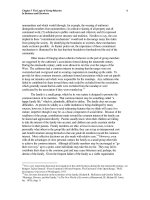Tài liệu Microeconomics for MBAs 9 docx
Bạn đang xem bản rút gọn của tài liệu. Xem và tải ngay bản đầy đủ của tài liệu tại đây (109.58 KB, 10 trang )
Chapter 2 Competitive Product Markets
40
the price at the pump remains constant at the price ceiling, does that mean that the
“real price” of gasoline has remained constant?
9. If the government imposes a price floor on whole milk and buys the resulting surplus, can it
later sell what it has bought and recoup its expenditure? What else can the government do
with the milk surplus? Why would you, as a milk producer, want the price floor? Show
the industry benefits in a graph.
10. Henry Ford more than doubled his workers’ wages. Did worker real income double by
Ford’s pay policy? Reflecting on the general principles behind Ford’s pay action, when
should any firm – your firm – stop raising the pay of workers (not in terms of actual dollar
amount but in terms of some economic/management principle that you can devise)?
11. Workers and their employers often talk about how workers “earn” their wages but about
how firms “give” their workers health insurance (or any other fringe benefit). Should the
different methods of pay be discussed in different terms?
12. In state universities, why does the state subsidize full-time MBA programs but not
executive MBA programs? Should the two programs be treated differently? Does the
state subsidy explain the price differential for students in the two programs?
READING: The Effect of Airline Deregulation on Travel Safety
William F. Shughart II, University of Mississippi
Before 1978 airlines in the United States were strictly controlled by government agencies. The safety of
airlines was, and remains today, regulated by the Federal Aviation Administration (FAA). In addition, the
Civil Aeronautics Board (CAB) controlled airline fares and routes. The effect of CAB regulations was to
restrict the ability of airlines to compete by price and entry into markets. Without CAB approval, for
example, Delta Airlines could not lower its air fares or enter new markets to expand its business.
In 1978 Congress passed legislation to eliminate gradually most of the economic controls the CAB had
over the domestic airline industry. However, airlines were not totally free to set prices and change routes
until 1983.
Many commentators fear that airline deregulation may have resulted in a reduction in the safety of air
travel in the United States.
1
From the perspective of economic theory, there are several reasons for
believing that air safety may have been compromised. First, airline deregulation has led to reductions in the
prices of many popular flights, especially long-distance flights (say, between New York and Los Angeles),
and travel by air may have increased. Deregulation may have increased the opportunity for air accidents.
Second, with the expansion of air travel, airlines may have had to draw on less experienced, qualified, and
careful pilots and mechanics.
Third, with greater competition in the airline industry, several airlines may have become unprofitable and
mangers may have reduced expenditures on needed plane repairs in order to increase airline profits. Fourth,
before airfares were deregulated, airlines may have competed in many nonprice ways—for example, meals
and in-flight service, movies, interiors of planes, and safety records. When they could compete by price
after deregulation, airlines may have sacrificed safety competition for price competition. All of these factors
may have led to increased air accidents and deaths.
Chapter 2 Competitive Product Markets
41
Economists have statistically investigated the effect of airline deregulation on airline safety. While the
debate continues, recent studies show that airline deregulation has in fact led to significantly more air travel
but that the number of airline accidents and deaths has not been affected.
2
Airline deaths have been on a
downward trend for decades, and airline deregulation does not appear (to date) to have slowed the pace of
decrease.
3
Economists have reasoned that the greater freedom given airlines by deregulation may have
been held in check by the considerable costs that airlines incur when they do have accidents. Airlines, in
other words, may have continued to maintain their safety records because of the fear and cost of liability
suits that are brought against them when they do have crashes. In addition, Congress never deregulated
safety.
Various government policies often have hidden, secondary market effects that economists and
policymakers must consider. Airline deregulation is a good case in point. Airline deregulation could have
reduced total travel deaths in the country by its indirect impact on highway travel and accidents.
By deregulating airlines fares, Congress increased air travel. At the same time, Congress increased the
relative cost of travel by car on the nation’s highways. This is because, as noted, after deregulation, air
travel became more convenient and often cheaper. Therefore, car travel became relatively expensive relative
to air travel.
Airline deregulation has had two distinct effects on automobile travel. It has had a price (or
substitution) effect. Less automobile travel would be expected with relatively lower airfares. Airline
deregulation has also had an income effect because greater efficiency in air travel may have led to more
national production and income. The greater national income may have led to more travel by air and cars.
Because the price and income effects of airline deregulation on automobile travel are not expected to be in
the same direction, theory alone does not give a clear answer to the question, “How has airline deregulation
affected automobile travel?” Statistical analysis is required, and the only study currently available on the
issue found that airline deregulation has, indeed, reduced travel by automobiles (by an annual average of
nearly 4 percent between 1979 and 1985).
4
However, because miles traveled on highways and automotive
accidents and deaths are likely to be directly related, the small estimated decrease in automobile travel may
have reduced automotive accidents and deaths by a sizable number. In fact, one of the authors estimates
that airline deregulation has probably reduced automobile accidents by an annual average of several
hundred thousand and deaths by an annual average of several hundred.
5
The indirect effects of policy changes, which are revealed through economic analysis, cannot be ignored
by policymakers. Policymakers need to be mindful of the fact that efforts to resurrect the type of airline
regulation abandoned in the late 1970s may, or may not, improve airline safety records. Re-regulation,
however, may cause people to shift from air travel to highway travel. Unfortunately, highway travel remains
far more dangerous than air travel, and unless precautions are taken, overall travel deaths can be increased
by airline re-regulation. This does not mean that re-regulation should not be undertaken but only that care
must be taken in designing any new economic controls on airlines.
1
See Hobart Rowen, “Bring Back Regulation,” Washington Post (National Weekly Edition), August 31,
1987, p. 5.
2
See Nancy L. Rose, Financial Influences on Airline Safety, no. 1890-87 (Cambridge, Mass.: Sloan School
of Management, Massachusetts Institute of Technology, 1987; and Richard B. McKenzie and William F.
Shughart II, “The Impact of Airline Regulation on Air Safety,” Regulation (January 1988), pp. 42-47.
3
Establishing the effect of airline deregulation
on
air travel and air accidents and deaths is more difficult than
it appears. This is because many factors affect air travel and deaths, including the amount of income people
in the economy have to spend. The very valuable statistical methods used by economists to separate the
impact of airline deregulation
from
people’s income are called econometrics.
4
Richard B. McKenzie and John T. Warner, The Impact of Airline Deregulation on Highway Safety (St.
Louis: Center for the Study of American Business, Washington University, December 1987).
Chapter 2 Competitive Product Markets
42
5
Ibid., p. 4.
CHAPTER 3
Principles of Rational Behavior at
Work in Society and Business
We are not ready to suspect any person of being defective in selfishness.
Adam Smith
ith this chapter we begin a detailed examination of key issues in
microeconomics, namely the study of how prices are determined in individual
markets. Prices are important – or, rather, should be important – to managers
because of their unavoidable impact on the decisions of managers within individual
firms. We have already seen how the forces of supply and demand determine prices
(Chapter 2). Now we will explore the determinants of the supply and demand for goods,
services, and resources.
Microeconomics rests on certain assumptions about individual behavior. One is
that people are capable of envisioning various ways of improving their position in life.
This chapter reviews and extends the discussion begun in Chapter 1 of how people –
business people included -- go about choosing among those alternatives. According to
microeconomic theory, consumers and producers make choices rationally, so as to
maximize their own welfare and their firms’ profits. This seemingly innocuous basic
premise about human behavior will allow us to deduce an amazing variety of
implications for business and every other area of human endeavor.
Rationality: A Basis for Exploring Human Behavior
People’s wants are ever expanding. We can never satisfy all our wants because we will
always conceive of new ones. The best we can do is to maximize our satisfaction, or
utility, in the face of scarcity. Utility is the satisfaction a person receives from the
consumption of a good or service or from participation in an activity. Happiness, joy,
contentment, or pleasure might all be substituted for satisfaction in the definition of
utility. Economists attempt to capture in one word—utility—the many contributions
made to our well being when we wear, drink, eat, or play something.
The ultimate assumption behind this theory is that people act with a purpose. In
the words of von Mises, they act because they are “dissatisfied with the state of affairs as
it prevails.”
1
1
Ludwig von Mises, The Ultimate Foundations of Economic Science: An Essay on Method (Princeton,
N.J.: D. Van Nostrad, 1962), pp. 2—3.
W
Chapter 3 Principles of Rational Behavior at
Work in Society and Business
2
The Acting Individual
If people act in order to satisfy their consciously perceived wants, their behavior must be
self -- directed rather than externally controlled. However, there is no way to prove this
assertion. Economists simply presume that individuals, as opposed to groups, perform
actions. It is the individual who has wants and desires, and looks for the means to fulfill
them. It is the individual who attempts to render his or her state “less unsatisfactory.”
Group action, when it occurs, results from the actions of the individuals in the
group. Social values, for instance, draw their meaning from the values held collectively
by individuals. Economists would even say that group action cannot be distinguished
from individual action. Although economists do not deny the existence of group
psychology, they leave the study of social groups to others. Thus to understand group
behavior, the economist looks to the individual.
Of course individuals in a group affect one another’s behavior. In fact, the size
and structure of a group can have a dramatic effect on individual behavior. When
economists speak of a competitive market, they are actually talking about the influence
that other competitors have on the individual consumer or firm.
Rational Behavior
When individuals act to satisfy their wants, they behave rationally. Rational behavior is
consistent behavior that maximizes an individual’s satisfaction. The notion of rational
behavior rests on three assumptions:
• First the individual has a preference and can identify, within limits, what he or
she wants.
• Second, the individual is capable of ordering his or her wants consistently,
from most preferred to least preferred.
• Third, the individual will choose consistently from these ordered preferences
to maximize his or her satisfaction.
Even though the individual cannot fully satisfy all her wants, she will always choose
more of what she wants rather than less. Furthermore, she will always choose less rather
than more of what she does not want. In short, the rational individual always stands
ready to further her own interests.
Some readers will find these assertions obvious and acceptable. To others, they
may seem narrow and uninspiring. Later in the chapter we will examine some possible
objections to the concept of rational behavior, but first we must examine its logical
consequences.
